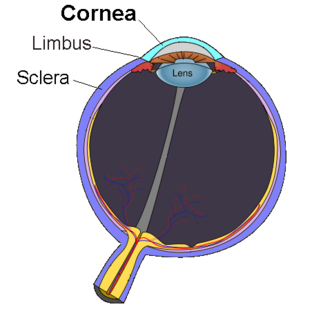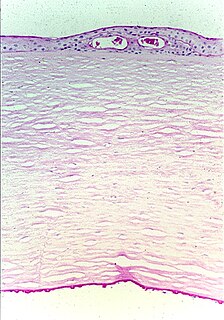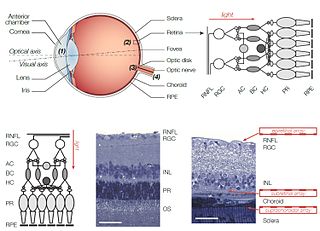Related Research Articles

Myopia, also known as near-sightedness and short-sightedness, is an eye disorder where light focuses in front of, instead of on, the retina. This causes distant objects to appear blurry while close objects appear normal. Other symptoms may include headaches and eye strain. Severe near-sightedness is associated with an increased risk of retinal detachment, cataracts, and glaucoma.

Peripheral vision, or indirect vision, is vision as it occurs outside the point of fixation, i.e. away from the center of gaze or, when viewed at large angles, in the "corner of one's eye". The vast majority of the area in the visual field is included in the notion of peripheral vision. "Far peripheral" vision refers to the area at the edges of the visual field, "mid-peripheral" vision refers to medium eccentricities, and "near-peripheral", sometimes referred to as "para-central" vision, exists adjacent to the center of gaze.

The cornea is the transparent front part of the eye that covers the iris, pupil, and anterior chamber. Along with the anterior chamber and lens, the cornea refracts light, accounting for approximately two-thirds of the eye's total optical power. In humans, the refractive power of the cornea is approximately 43 dioptres. The cornea can be reshaped by surgical procedures such as LASIK.

A pterygium of the eye is a pinkish, roughly triangular tissue growth of the conjunctiva onto the cornea of the eye. It typically starts on the cornea near the nose. It may slowly grow but rarely grows so large that it covers the pupil and impairs vision. Often both eyes are involved.
The visual field is the "spatial array of visual sensations available to observation in introspectionist psychological experiments". Or simply, visual field can be defined as the entire area that can be seen when an eye is fixed straight at a point.

Fuchs dystrophy, also referred to as Fuchs endothelial corneal dystrophy (FECD) and Fuchs endothelial dystrophy (FED), is a slowly progressing corneal dystrophy that usually affects both eyes and is slightly more common in women than in men. Although early signs of Fuchs dystrophy are sometimes seen in people in their 30s and 40s, the disease rarely affects vision until people reach their 50s and 60s.
Anterior ischemic optic neuropathy (AION) is a medical condition involving loss of vision caused by damage to the optic nerve as a result of insufficient blood supply (ischemia). This form of ischemic optic neuropathy is generally categorized as two types: arteritic AION, in which the loss of vision is the result of an inflammatory disease of arteries in the head called temporal arteritis, and non-arteritic AION, which is due to non-inflammatory disease of small blood vessels.
Diabetic angiopathy is a form of angiopathy associated with diabetic complications. While not exclusive, the two most common forms are diabetic retinopathy and diabetic nephropathy, whose pathophysiologies are largely identical. Other forms of diabetic angiopathy include diabetic neuropathy and diabetic cardiomyopathy.

Retinal prostheses for restoration of sight to patients blinded by retinal degeneration are being developed by a number of private companies and research institutions worldwide. The system is meant to partially restore useful vision to people who have lost their photoreceptors due to retinal diseases such as retinitis pigmentosa (RP) or age-related macular degeneration (AMD). Three types of retinal implants are currently in clinical trials: epiretinal, subretinal, and suprachoroidal. Retinal implants introduce visual information into the retina by electrically stimulating the surviving retinal neurons. So far, elicited percepts had rather low resolution, and may be suitable for light perception and recognition of simple objects.

A vergence is the simultaneous movement of both eyes in opposite directions to obtain or maintain single binocular vision.
Sattler's layer, named after Hubert Sattler, an Austrian ophthalmologist, is one of five layers of medium-diameter blood vessels of the choroid, and a layer of the eye. It is situated between the Bruch's membrane, choriocapillaris and Haller's layer below, and the suprachoroidea above, respectively. The origin seems to be related to a continuous differentiation throughout the growth of the tissue and even further differentiation during adulthood.

A pinguecula is a common type of conjunctival stromal degeneration in the eye. It appear as an elevated yellow-white plaque in the bulbar conjunctiva near to limbus. Calcification may also seen occasionally.

Emmetropia is the state of vision in which a faraway object at infinity is in sharp focus with the eye lens in a neutral or relaxed state. That condition of the normal eye is achieved when the refractive power of the cornea and eye lens and the axial length of the eye balance out, which focuses rays exactly on the retina, resulting in perfect vision. A human eye in a state of emmetropia requires no corrective lenses; the vision scores well on a visual acuity test.
A spasm of accommodation is a condition in which the ciliary muscle of the eye remains in a constant state of contraction. Normal accommodation allows the eye to "accommodate" for near-vision. However, in a state of perpetual contraction, the ciliary muscle cannot relax when viewing distant objects. This causes vision to blur when attempting to view objects from a distance. This may cause pseudomyopia or latent hyperopia.

Nyctalopin is a protein located on the surface of photoreceptor-to-ON bipolar cell synapse in the retina. It is composed of 481 amino acids. and is encoded in human by the NYX gene. This gene is found on the chromosome X and has two exons. This protein is a leucine-rich proteoglycan which is expressed in the eye, spleen and brain in mice. Mutations in this gene cause congenital stationary night blindness in humans (CSNB). which is a stable retinal disorder. The consequence of this mutation results in an abnormal night vision. Nyctalopin is critical due to the fact that it generates a depolarizing bipolar cell response due to the mutation on the NYX gene. Most of the time, CSNB are associated to hygh myopia which is the result of a mutation on the same gene. Several mutations can occur on the NYX gene resulting on many form of night blindness in humans. Some studies show that these mutations are more present in Asian population than in Caucasian population. A mouse strain called nob carries a spontaneous mutation leading to a frameshift in this gene. These mice are used as an animal model for congenital stationary night blindness.

Meibomian gland dysfunction is a chronic disease of the meibomian glands, which is commonly characterized by obstruction of the end of the duct that delivers the secretion produced by the glands to the eye surface, which prevents the glandular secretion to reach the ocular surface. The dysfunction could be that the amount of secretion produced may be abnormal. Dysfunction could also be related to the quality of the meibum produced. MGD may result in evaporative dry eye, blepharitis, chalazion, unsealed lid during sleep, and meibomian gland atrophy.

Lanepitant (INN, code name LY303870) is a drug developed by Eli Lilly which acts as a selective antagonist for the NK1 receptor, and was one of the first compounds developed that act at this target. It was under development as a potential analgesic drug, but despite promising results in initial animal studies, human clinical trials against migraine, arthritis and diabetic neuropathy all failed to show sufficient efficacy to support further development, with the drug being only marginally more effective than placebo and inferior to older comparison drugs such as naproxen. Failure of analgesic action was thought to be due to poor penetration of the blood–brain barrier in humans, but research has continued into potential applications in the treatment of other disorders with a peripheral site of action, such as corneal neovascularization.

Befetupitant (Ro67-5930) is a drug developed by Hoffmann-La Roche which acts as a potent and selective antagonist for the NK1 receptor. It was originally developed as a potential antiemetic drug, though development was ultimately discontinued after a related drug netupitant was deemed to be more suitable for clinical development. Befetupitant has however continued to be researched for other possible applications such as treatment of corneal neovascularization.
Geographic atrophy (GA), also known as atrophic age-related macular degeneration (AMD) or advanced dry AMD, is an advanced form of age-related macular degeneration that can result in the progressive and irreversible loss of retinal tissue which can lead to a loss of visual function over time. It is estimated that GA affects >5 million people worldwide and approximately 1 million patients in the US, which is similar to the prevalence of neovascular (wet) AMD, the other advanced form of the disease.

Omidenepag isopropyl is a pharmaceutical drug used for the treatment of glaucoma and ocular hypertension.
References
- ↑ Kwok, L. Stephen; Kuznetsov, Valerian A.; Ho, Arthur; Coroneo, Minas T. (2003-04-01). "Prevention of the Adverse Photic Effects of Peripheral Light-Focusing Using UV-Blocking Contact Lenses". Investigative Ophthalmology & Visual Science. 44 (4): 1501–1507. doi: 10.1167/iovs.02-0380 . ISSN 1552-5783. PMID 12657585.
- ↑ King-Smith, P. Ewen; Mauger, Thomas F.; Begley, Carolyn G.; Tankam, Patrice (2020). "Optical Analysis and Reappraisal of the Peripheral Light Focusing Theory of Nasal Pterygia Formation". Investigative Ophthalmology & Visual Science. 61 (2): 42. doi:10.1167/iovs.61.2.42. ISSN 0146-0404. PMC 7329627 . PMID 32106293.